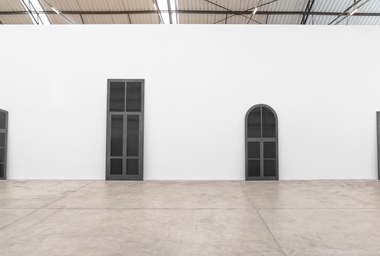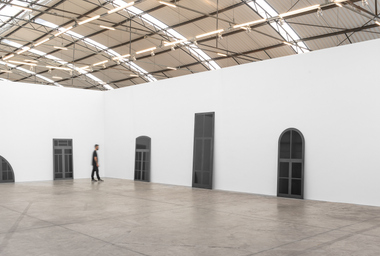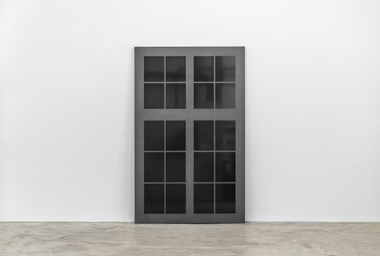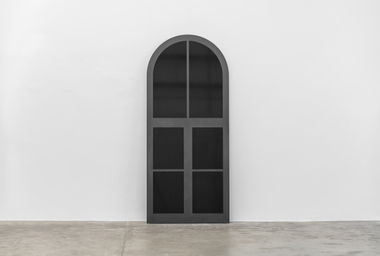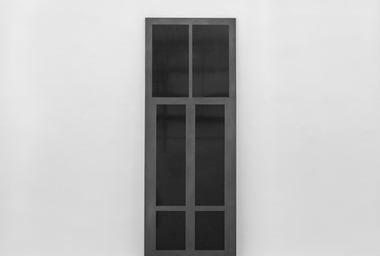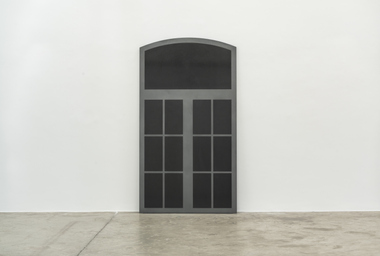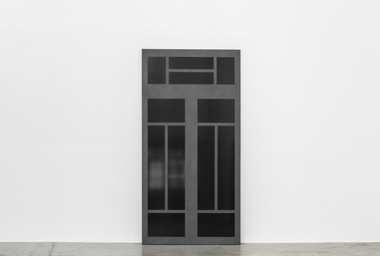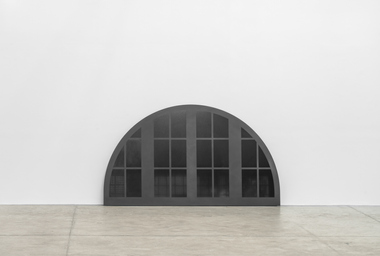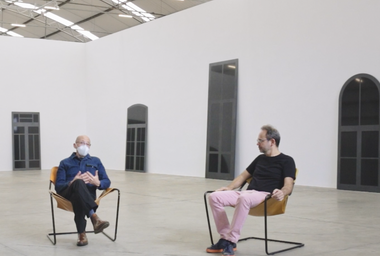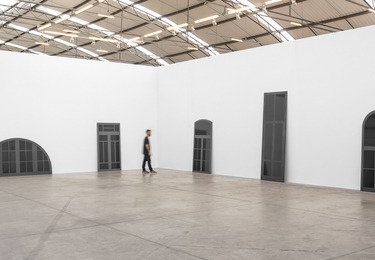
Iran do Espírito Santo
Janela Reflexiva
May 7 – Jun 11, 2022
Opening
May 7, 2 pm–6 pm
FDAG Barra Funda
Download
Fortes D’Aloia & Gabriel is pleased to present Janela Reflexiva, a solo show by Iran do Espírito Santo at Galpão, in São Paulo. Six large-scale granite sculptures mimic windows of existing places, appropriated from museums, houses, and churches. The frames are represented by matt areas and the glasses by polished, highly reflective areas. Espírito Santo suspends the functional nature of the referred object, inverting its primordial function. The body of work is thus situated between interior and exterior, image and abstraction, access and isolation.
Reflective Windows
By Guilherme Wisnik
Parallels between the window and the painting have often been drawn. As described by Leon Battista Alberti in the 14th century, paintings are like open windows to the world. That is, the space created by Renaissance painting, through the use of perspective, broke through the enclosure of the medieval flat space, allowing the canvas, when hung on the wall, to work as a sort of window that found its way through the solidity of the brickwork, leading the gaze towards the depth of the outside.
We know that this conception of painting as a window fell into crisis in modernity, as the canvas became a flat, opaque screen, impermeable to the illusionist’s attempts to visually traverse it in search of a depth of space. At the threshold of this story, Robert Rauschenberg slathered paint on his bed and hung it vertically on the wall, like a canvas. In the “expanded field” of art in the second half of the 20th century, the frontiers between painting and sculpture were blurred, and its transparency value declined.
In the installation Janela Reflexiva at Fortes D’Aloia & Gabriel, artist Iran do Espírito Santo occupies the space with six granite sculptures. Each black piece reproduces a specific window from somewhere in the world, appropriated by the artist, but still maintaining its measurements and proportions. In them, the elements that correspond to the window frames – in wood or iron – are left opaque and matted, through shotblasting, whilst the elements that correspond to the windowpanes are polished, therefore reflective. As such, the sculptures perform a suggestive inversion of their original references. The first, and most obvious, is the replacement of the glass’ transparency with the opacity of the granite, which, partially polished, also acquires a reflective consistency. The second is the explicitness of the weight of these stone pieces, which in contrast to the diaphanous real windows – which are open in the middle or at the top of the walls, like voids in the solid plane – lie heavily on the floor, assuming a position of sculpture: they are solid objects, rather than the void. Here, our gaze is not attracted by the light that comes from outside but rather by works that attract all the light towards them, bringing it to the ground.
Appropriated from museums, homes, ships and cathedrals in São Paulo (in the capital and inland), Switzerland and Italy, each one of the six windows is different. Predominantly vertical, some of them are rectangular, others have curvy finishes at the top, and one of them, smaller, is shaped like a semi-circle. Placed directly onto the floor, they form a somber, monochromatic set, as if Malevich’s black squares on a white background had become space. Notably, if Piet Mondrian said that his paintings had to burst out of the canvas plane to become design objects, architectural constructions, cities, and the real world, in this installation, Iran do Espírito Santo takes the reverse route: the windows of the “real world” are sucked back into the exhibition space like a set of aligned black geometric solids. But no deep and luminous space is created, instead they resemble tombstones.
The Greek etymology of the word “monument” incorporates the idea of remembering, also implied in mausoleum. The monument exists so we can mourn those who have gone, but who are once again present before us through the monument. Many of Iran do Espírito Santo’s works – both sculptural and pictorial – are related to this funerary sense of monument, appropriating objects from the world (generally everyday items) and reproducing them in veiled, blind, dark ways. But if this operation owes much to pop art (let us think, for example, of Claes Oldenburg’s sculptures), the visual treatment delivered by Iran is rigorously anti-pop, as it rejects the image appeal of detail and color in favor of a somber, cold, clearly minimalist laconism: ideal forms stripped of content.
However, the Brazilian artist is not tied down by any minimalist literalness. Using irony and mystery, Iran do Espírito Santo not only empties the objects of meaning, but also reverses our perception of them, such as in Untitled (Keyhole, 1999), in which he uses stainless steel to build the empty shape of a keyhole, making it both solid and ambiguously reflective. In Déjà vu (2001), a work that anticipates many of the issues behind the installation presented here, Iran paints directly onto the wall scenes that resemble reflections of light entering through windows on the opposite walls, with their well-defined vertical and horizontal bars. These veiled paintings, made in variations of gray emulating the presence of light filtered by the windows, are in close dialogue with Alberti’s maxim, while introducing a new layer of complexity: here the painting does not emulate a window, that is, it is not presented as the illusion of an opening to the world; instead, it is a reflection – on an indoor wall – of a window that does not exist.
Born and raised in Mococo, in inland São Paulo, which he left in his late teenage years, the artist tells us that he enjoyed visiting the cemetery. The highly ornate tombstones were suggestive of sculptural references, and the ample and empty space was a counterpoint to the often oppressive and claustrophobic environment of small towns, where you are constantly under the controlling gaze of others. But here, in Janela Reflexiva, which in some ways evokes these past experiences, the claustrophobia returns through art: our gaze is not able to see anything beyond the black objects. Like faulty mirrors, they give us back our own image as a shadow, blurred by the cloudiness of the dark stone. Everything comes back inside, infinitely, in a sort of morbid and despairing narcissism that does not fail to comment on the confinement in which we live and the current state of dismantling being inflicted on our country, which only a decade ago seemed to be opening up to the world beyond in such a proud and dignified way.
What images can we make of ourselves at this point in the century? What is left to the imagination in such an oppressive context? What are our chances of escaping this enclosed labyrinth, this noisy echo chamber, made of distorted and manipulated realities? In the solemn silence of the artist’s installation we cannot see anything outside this labyrinth, but we find peace to better reflect on our state of confusion. After all, what is taking shape before us inside the black fog? Are we being observed by hidden presences, mirroring what happens with the ongoing kidnapping of our data by algorithms? In the twilight, the windows lit from inside, typically transparent, become opaque and reflective, inverting the perception between observer and observed. Here, in a parallel way, the mystery reinforces the ambivalent meaning of the artwork. Should we look inside or outside?
